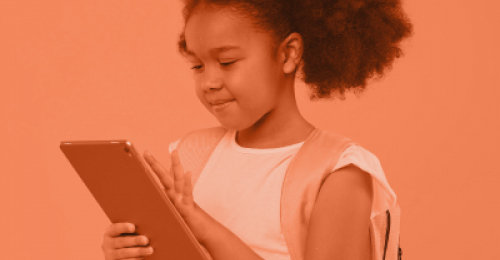Do you have a good practice in digital education?
From the OAS Alliance and ProFuturo Foundation we are looking for you! Join our project and be part of the second edition of our mapping, with the most innovative practices that have been carried out in the Americas between 2022, 2023 and 2024.
This activity calls for projects focused on digital education and new technologies developed by schools and/or civil society organizations in Latin America and the Caribbean.
You can consult the terms and conditions of participation here.
Please, to fill out the mapping form, click on the "inscripción abierta/open enrollment" button on the right ➡️

The Second Mapping of Best Practices in Digital Education in the Americas (hereinafter, the "Mapping"), organized by the General Secretariat of the Organization of American States (GS/OAS) and ProFuturo (hereinafter, the "Organizers") has the following objectives:
- Highlight initiatives by educational institutions and civil society organizations in Latin American and Caribbean countries that promote educational improvements through digital technologies.
- Analyze common and original aspects among these initiatives in order to build knowledge about their starting points, purposes, characteristics and results.
- Systematize information on initiatives to promote its transfer to other contexts and contribute to the promotion of digital education in the region.
Find the terms and conditions of the mapping here.
Good practices may be applied:
1) Civil Society Organizations from Latin American and Caribbean Countries; and
2) State-run or privately run educational institutions, at the initial, primary or secondary level of all modalities, provided that they are duly recognized as such by the competent government entity of Latin American and Caribbean countries.
Participating Entities may apply for more than one good practice, as long as the latter has been developed by a different teacher, director or representative of a different civil society organization.
There are multiple dimensions and purposes of digital education. Among them, we can recognize, for example: access to educational opportunities and the increase in levels of equity and inclusion in systems, the improvement of the relevance and quality of learning, the development of digital skills or education and learning management systems.
In this mapping, we will consider "best practices in digital education" to be initiatives that include digital or technological components developed by civil society organizations, management teams, and teachers of educational institutions in Latin America and the Caribbean, aimed at one or more of the following purposes:
- Promote a more inclusive and equitable education. The digitization of learning tools and resources can expand access to learning and teaching materials and, therefore, increase learning opportunities for the most disadvantaged students. In this case, technologies enable the timely detection of students with specific learning difficulties or needs and also offer accessible resources and activities for these students. Through virtual teaching, it is possible to guarantee access to education to populations in remote contexts, in disaster situations or with difficulties in accessing schools or to improve educational opportunities for populations that had access to low-quality services. Technologies provide activities and tools that can be used to accelerate the learning of those students who have not reached certain learning goals and/or who require additional time to interact with the content. Another important advance in this regard is digital information systems from which timely and systematic information can be obtained about students and interventions can be carried out aimed at sustaining their educational trajectory and preventing school repetition or dropout. Some examples of digital technologies used for this purpose are: applications for the diagnosis of dysgraphia or dyslexia, accessible materials or activities for blind or deaf students, intelligent tutoring systems or MOOCs used to reinforce or accelerate the learning of students who need it most, early warning systems.
- Promote specific digital skills in students. In the context of the exponential advance of technologies, it is increasingly necessary to train future generations in digital skills that allow them, among other things: to participate responsibly in the processes of socialization and the construction and circulation of knowledge in the digital world; operate and think critically with the information available in cyberspace, interact meaningfully with digital resources that expand or enhance our capacities, coexist respectfully with others on social networks, analyze and reflect on the impact of digital technologies and environments on human life and development. Unlike the previous purpose, in this case, the priority and focus of the use of technologies is placed on the development of digital skills in students, although this may also be relevant for the teaching of specific content
- Offer a more personalized education for students. Technologies can be used to produce relevant, timely and dynamic information about each student and their learning process, which is a central input for teaching and for the interventions carried out by schools aimed at sustaining and improving their educational trajectory. They also offer the opportunity to assist students individually in their learning, propose activities and guide them according to their levels of achievement, previous knowledge, interests, styles and rhythms. Some examples of this are: digital systems for teaching or evaluating specific content such as mathematics or reading fluency or comprehension, artificial intelligence systems for tutoring, student guidance systems for higher education.
- Strengthen or enhance teacher training and professional development. Digital education not only includes students but also directors and teachers of the education system. Technologies provide new opportunities for teacher professional development based on virtual training, digital networks and communities for socialization and learning among teachers, platforms for access to resources and practices of other colleagues, teacher performance evaluation devices or systems for digitizing the teacher file and professional development. Some examples of this can be virtual experiences of initial or continuous teacher training for remote contexts or to improve the quality of programs, experiences of digital systems for evaluation and feedback of teacher performance, networks or social platforms that bring together teachers or digital files of teachers from which the instances of training and/or accreditation of knowledge and professional skills are registered.
- Enrich the teaching and learning of school content. Digital technologies provide different platforms, software and resources that can enhance, update or dynamize teaching. There are software aimed at teaching and learning specific content, platforms that teachers can use as support systems for teaching inside and outside the classroom, tools specific to disciplinary fields that can be integrated into curricula to update students' training. Some examples of technologies used for this purpose are mathematics or physical science learning software, virtual teaching platforms, artificial intelligence bots or digital design tools or simulators.
In the presentation of experiences for Mapping, it is recommended to frame the Good Practice to a single main purpose or a maximum of two, beyond the fact that it may contribute secondarily to other purposes. This framing allows us to clearly identify the main sense by which the experience was developed.
Participating Entities may apply for more than one good practice, as long as the latter has been developed by a different teacher, director or representative of a different civil society organization.
Requirements
This Best Practice Mapping requires that the experiences presented:
- are based on the right to education, that is, they conceive of education as a fundamental process for the development of individuals and societi and that contribute to improving educational opportunities and the quality of training to which students and teachers have access;
- integrate ICT (Information and Communication Technologies) and/or TACs (Learning and Knowledge Technologies) into education systems, schools, classrooms or teacher professional learning communities to promote educational opportunities and improve the quality of education;
- have evidence of their progress or results, in other words, these are experiences that are documented through sources or records of information (for example: written projects, audiovisual or visual materials, productions of teachers and/or students, among others).
- they are or have been sustained over time, that is, they are systems, communities of practice, projects, curricula or didactic sequences that are in development that have been completed and whose implementation is carried out over a period of time. Experiences related to specific classes or isolated and short-term interventions will not be considered.
The experiences presented may not have been those selected in the First Mapping of Good Practices carried out in 2022.
Criteria
The set of criteria that will be considered to assess the practices in this mapping is listed below.
· Equity approach. Experiences aimed at guaranteeing the right to education to populations in conditions of socioeconomic vulnerability or belonging to minority groups (migrant and/or rural and/or indigenous and/or disabled population, or others) and girls or adolescents will be valued. Taking into account the latter, experiences with a gender focus will be valued.
· Pertinence. It is expected that the experience presented will contribute effectively to the proposed purpose(s). This implies that there is a logical relationship between the initial problems or diagnoses, the purposes that are proposed and the strategies or interventions that are carried out.
· Centrality of technologies. It will be valued that ICT or TACs are used in a strategic and relevant way to achieve the purpose or purposes in which the experiences are framed.
· Systematization. It is expected that the practices are described and documented and that they clearly define their foundations, objectives, actors involved, strategies or interventions, times and progress or results.
Replicability. The evaluation will consider the feasibility of implementing the practices in other institutions and contexts. To this end, it will give special consideration to the resources required for its development and the efforts and adaptations that would be necessary for its transfer.
At the end of the call:
- There will be 4 documentary videos (no longer than 3 minutes) of the most outstanding mapping practices, which will be disseminated on the OAS and ProFuturo social media channels.
- A systematization will be developed on all the good practices presented that meet the selection criteria, seeking to publicize the type of initiatives developed through a compendium of good educational practices.
- The good practices presented that meet the selection criteria will be published on an interactive map hosted on a web page of the OAS Educational Portal as a repository open to the general public.
- Diploma recognizing outstanding good practices in mapping
- Communication to the Ministries of Education of the Countries of the Americas on the outstanding practices of their country.
By providing the information requested by this act, you consent to the processing of your personal data by the General Secretariat of the Organization of American States (GS/OAS) exclusively for the development and monitoring of the Mapping of Good Practices in Digital Education of the Americas. (hereinafter Program) and to share future activities and opportunities of the GS/OAS. The Processing of Personal Data includes the collection, storage, use, transfer, disclosure and deletion of the files of the GS/OAS, regardless of whether the handling is automated or not.
In some cases, the GS/OAS may share your Personal Data with third parties when the purpose for which it was collected so requires, including for program audit purposes or at the request of the donor funding the Program. The GS/OAS does not sell Personal Data to third parties.

Doubts and questions can be sent to the mail: [email protected]
¿Está interesado en este curso?
Modality: Virtual
Duration: 1 week(s)
Start: October 15 2024
Weekly dedication: 1 hours
Application deadline: November 20 2024





